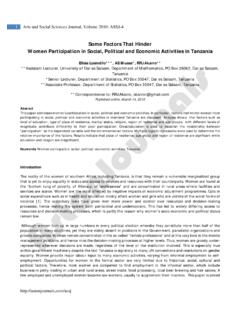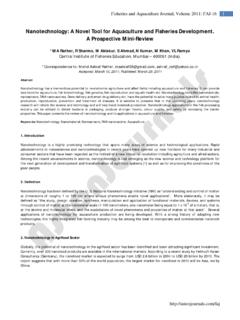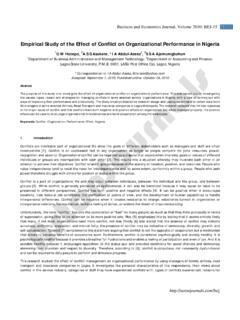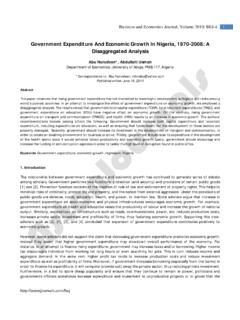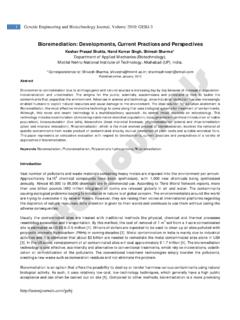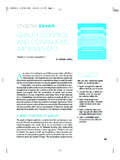Transcription of Semi-Autonomous Work Team Implementation in …
1 1 Business and Economics Journal, Volume 2011: BEJ-27 Semi-Autonomous work team Implementation in manufacturing Cells Using a Simplified Project Management LA Junior*, O Novaski Department of Production Engineering, Institute of Mechanical Engineering, Unicamp, Campinas, S o Paulo, Brazil. *Correspondence to: Laercio Avileis Junior, Accepted: April 5, 2011; Published: July 30, 2011 Abstract A change in a social system such as Semi-Autonomous work team can be conducted in both ways - change management and project management - according to literature.
2 This work developed a simplified project management methodology to implement self-management cells that are a type of organization in which employee groups are in charge of a complete sequence of work in the production process of goods for internal or external clients. The objective is to adapt a methodology used in project management as a way of organizing change to allow the empowerment of the workers in the manufacturing cells, through identifying the requirements for Implementation and assessment of the self-directed concept.
3 This work is a result of nine years of research-action methodology applied to a self-management cell in an auto parts manufacturing company and accomplished the Implementation of Semi-Autonomous work teams. Improvements were achieved in logistics and inventory reduction, both for parts and for machining tools. The financial consequences of these improvements showed a break-even of the invested amount within 8 months. Keywords: Semi-Autonomous work team ; self-management cell; change management; self-directed work teams; simplified project management; empowerment; manufacturing cells.
4 1. Introduction The great range of products from external enterprises puts the costumer in the position of being able to choose from several offerings for the same product. It changed the current vision of economy to that in which the market, and not the companies, dictates the laws of consumption. Traditional concepts outlined by Taylor and Ford at the beginning of the century based on individualized work for the pursuits of productivity were insufficient [1]. The adoption of Semi-Autonomous work teams, even called self-management teams or self-directed work teams, by world-class companies shows that such hypotheses are being abandoned.
5 A simplified project management method [2] was applied for the change management and it was revealed a good tool for both monitoring and controlling the change. This work is a result of 9 years of research-action methodology applied to a self-management cell and accomplished the implementations of self-directed work teams. A Brief History of autonomous Groups Several studies [3, 4] credit the Tavistock Institute in London and their socio-technical treatment for the creation of autonomous groups, as described in the beginning of the 1950s.
6 The genesis of high performance organizations, through work teams, was described by Ken Bamforth, unionist and former coal miner who was a student of the Tavistock Institute for Social Research (Tavvy), co-founded by Eric Trist. Bamforth found out that miners created by themselves a work organization that brought out significant improvements in terms of productivity, cost, time-cycle, absenteeism and morale of employees. Bamforth was the pioneer in the socio technical treatment of the redesign of work [5].
7 During the 70s, the interest grew in Scandinavian countries, particularly in Norway and Sweden. In those countries, experiments carried out by Volvo (The Volvo Group-manufacturer of buses in Sweden) and Saab (Scania Group-manufacturer of heavy trucks in Sweden), succeeded and were discussed throughout the industrial world. From the end of the 70s to the mid-80s, the interest mixed with the movement for Quality of working life , which 2 Case Report favored a profound transformation of the means of labor through agreements between unions and employers, and the creation of Semi-Autonomous groups of production workers [3].
8 Around 1985, the attention given to independent groups was eclipsed by the success, in Japan, of the Quality Control Circle - QCC and its adoption throughout the world. Japan has replaced Sweden as a model of teamwork. Its popularity declined in the beginning of the 90 s when some of the experiments failed [3]. Organizational Culture As it comprises a change of beliefs and work methods, there has to be an alteration of the state known as organizational or corporate culture.
9 The implementations compulsorily lead to a change of the organizational culture. A self-management team is usually empowered to share various functions with managers and leaders. If several of the typical responsibilities of leaders have not been transferred to the teams and the roles and responsibilities of the leaders have not changed significantly, the organization probably is not implementing autonomous teams. In other words, self-management teams require a complete transformation of the culture of the organization" [6].
10 Initiative and incentive culture. Taylor uses the term "initiative" to designate every worker's good qualities and points out that the average worker avoids giving their full initiative: .. workers believe that it is positively against their interests to employ their best initiative and, instead of giving efforts to achieve the biggest quantity of work with the best quality, they deliberately work as slowly as possible while trying to convince their employers that they work fast [7].
